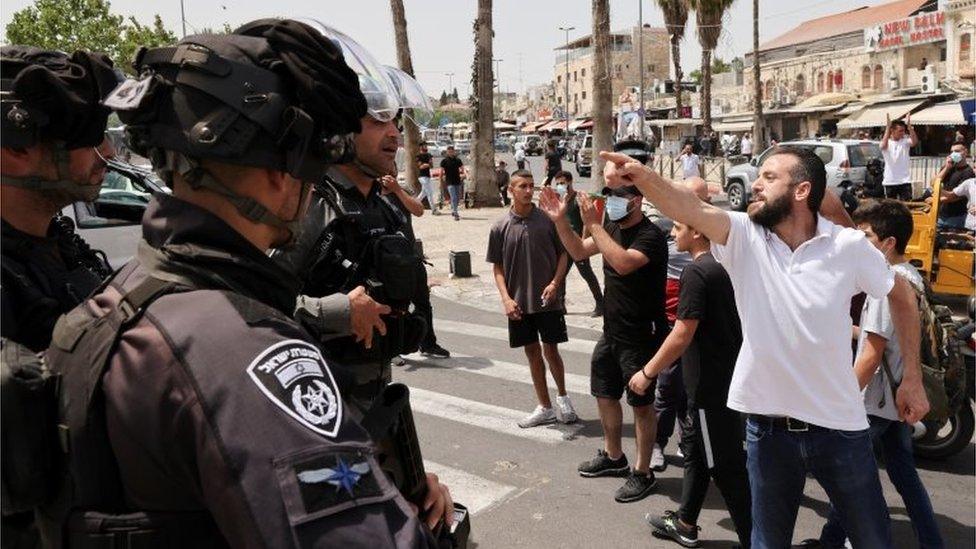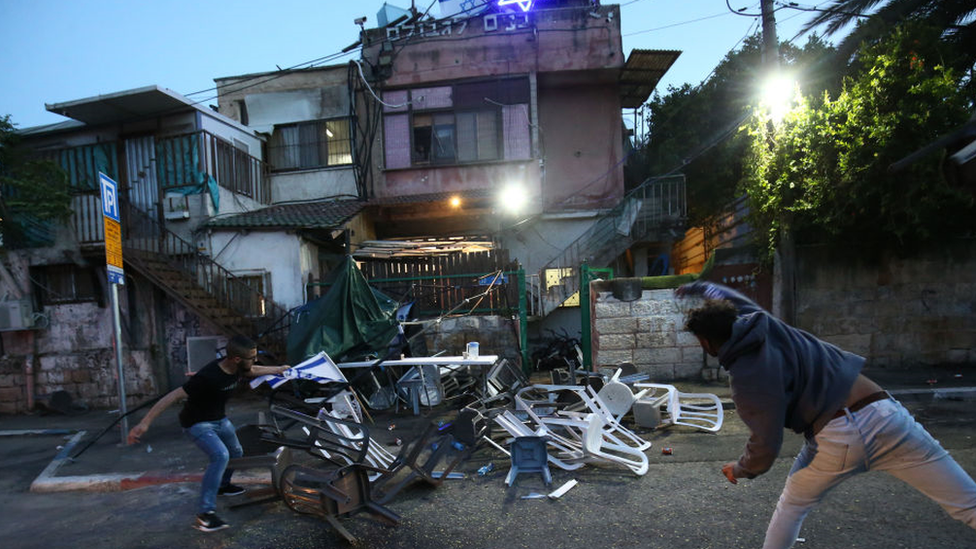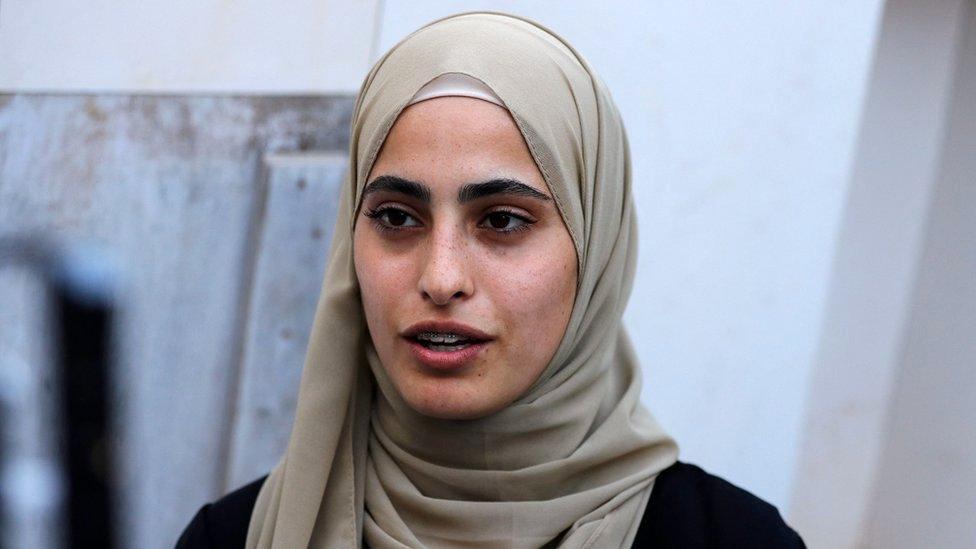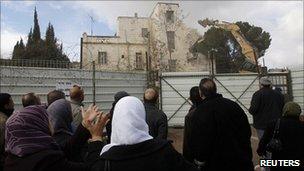Sheikh Jarrah: Why could Palestinians lose their homes in Jerusalem?
- Published

Tensions in Jerusalem escalated earlier this year
Israel's highest court is considering a key legal case that involves Palestinians who face losing their homes in a part of Jerusalem they have lived in for decades.
Palestinian families have rejected a compromise offer by the court to rent their homes from a Jewish settlement organisation.
The fate of the families in the Sheikh Jarrah area - and others threatened with eviction in East Jerusalem - has led to weeks of protests and clashes.
What is the dispute about?
Sheikh Jarrah is a Palestinian neighbourhood in Israeli-occupied East Jerusalem, close to the Old City and its holy sites.
There is a long-running dispute over who owns land in the area, which has seen Jewish settler groups pursue evictions against Palestinians who had moved in as refugees.

The geography of this small district in Jerusalem is central to the Israel-Palestinian conflict.
Israel considers the entire city its capital - something not recognised by most of the international community.
Palestinians want East Jerusalem to be the capital of a future Palestinian state.

What has been happening in Sheikh Jarrah?
Jewish associations bought land near holy Jewish monument the tomb of Shimon Hatzadik, in Sheikh Jarrah, in 1876, and a community lived there for decades.
But after the 1948-49 Arab-Israeli war, Jerusalem, where Arabs and Jewish people had lived side by side, was divided between the state of Israel and the Kingdom of Jordan.
Jewish people had been displaced from the eastern and Palestinians from the western half of the city.

May saw fighting in Sheikh Jarrah
And Jordan controlled East Jerusalem, becoming responsible for the Palestinian refugees who had moved there.
With United Nations help, the Jordanian authorities built 28 homes for some of these refugees, on land in Sheikh Jarrah previously held by the Jewish associations but taken over by the Jordanian Custodian of Enemy Property.
These families were promised - but never received - legal land titles.
"The original families chosen by the UN Palestinian refugee agency (Unrwa) have now become more than 60 families that comprise over three generations of Palestinians living in Sheik Jarrah," according to a recent report by a UN special rapporteur, external.
But after the June 1967 war, Israel occupied East Jerusalem and applied its own laws - something the UN says is illegal.
Why the ancient city of Jerusalem is so important
In 1970, a law was introduced to process the competing ownership claims in places such as Sheikh Jarrah.
And lands the Jordanian authorities had classified "enemy property" between 1948 and 1967 were transferred to the Israeli Custodian General, the body in charge of returning land to its original owners before 1948 - or their heirs.
Palestinians, however, do not have equal power to recover property they lost in West Jerusalem, or elsewhere in Israel, which under a 1950 law was declared abandoned and moved under state control - although, they can claim compensation.
Two Jewish associations, in some cases producing Ottoman-era documents, were awarded the rights to the land in Sheikh Jarrah on which the homes for Palestinian refugees had been built.
And they later sold the land to settler group Nahalat Shimon, which has spearheaded the eviction cases and wants to expand the Jewish presence in predominantly Palestinian parts of East Jerusalem.

Palestinian activist Muna el-Kurd, a prominent Sheikh Jarrah resident, was questioned by Israeli police in June
Some Palestinians were given "protected tenant status", including through an agreement, in 1982, involving 17 Sheikh Jarrah families.
But this effectively validated the 19th Century property deeds presented by the Jewish groups and meant families would pay rent to their new landlords and require permission to expand the homes.
The families later rejected the agreement.
And there are doubts whether the Palestinians knew what they were signing up for.
"It appears that at no point did the families give consent to or were consulted on the settlement negotiated by the lawyer, who did not represent all Palestinian families living in Sheikh Jarrah," UN special rapporteurs say.
In the early 1990s, the families stopped paying rent and the Jewish trusts began legal proceedings against them.
In 2020, a court in Jerusalem found in favour of Nahalat Shimon and issued eviction notices to several families, affecting dozens of people.
The Supreme Court has tried to mediate between the two camps - and a proposal included the families pay rent - but this has been rejected by the Palestinians.
The Jewish settlers want full recognition of ownership - but the families refuse to accept this.
They "have resided in these homes for nearly 70 years", says the UN.
"They are now at risk of being displaced for the second time in living memory."

The UN says the laws guiding who has the right to property in Jerusalem are "applied in an inherently discriminatory manner, based solely on the nationality or origin of the owner".
But the Israeli government says it is entitled to build in the city it considers its capital - and the evictions are private property matters to be resolved by landlord and tenant.
Notable examples highlight the competing claims.
The Shepherd Hotel, in Sheikh Jarrah, for example, was declared an "absentee property" under Israeli law and the title moved to an Israeli company and later bought by an American millionaire who razed the building to make way for a settlement.
Palestinians say the building was taken illegally, external.

Palestinians accused Israel of trying to "erase" them from the city
There are about 3,000 settlers in predominantly Palestinian neighbourhoods in East Jerusalem - almost all in and around the Old City in places such as Sheikh Jarrah, Peace Now, an Israeli non-governmental organisation, says.
And since the start of 2020, the local magistrates' court has ordered the removal of 36 families from Batan Al-Hawa and Sheikh Jarrah, which is currently the subject of appeal.
Across the city, the UN estimates, at least 970 Palestinians, external are at risk of forced removal due to cases brought before Israeli courts.
Local regulations also make it difficult for Palestinians to expand their homes.
Between 1991 and 2018, 9,536 housing units were approved for construction in Palestinian neighbourhoods in East Jerusalem, compared with 21,834 in Israeli neighbourhoods, according to Peace Now, external.
And because of the bureaucratic obstacles, much building work is done illegally, leading to demolitions by Israeli authorities.
